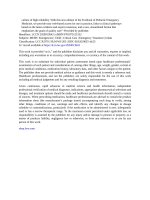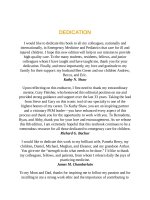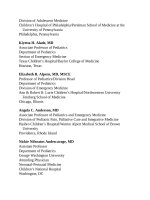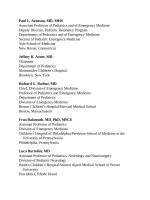Pediatric emergency medicine trisk 0830 0830
Bạn đang xem bản rút gọn của tài liệu. Xem và tải ngay bản đầy đủ của tài liệu tại đây (101.61 KB, 1 trang )
Approach
The goals of management are to define specific anatomic lesions (e.g., skull
fracture and TBI) and to prevent secondary brain injury, while limiting
unnecessary cranial irradiation. Pediatricians and emergency physicians will be
the initial clinicians to evaluate and manage most children with head trauma.
Neurosurgical consultation should be considered for all children with penetrating
trauma, abnormal mental status or neurologic examination, skull fractures, and
intracranial complications. The urgency of neurosurgical involvement varies with
the acuity of the patient’s clinical condition.
One approach to diagnosing complications of head trauma involves
determining whether a penetrating injury has occurred. If so, brain or vascular
injury is likely and emergent CT scanning and neurosurgical consultation are
mandated in addition to stabilization.
If the head injury has resulted from blunt trauma, it must be determined
whether a TBI is likely ( Fig. 41.1 ). Since preverbal children may have
differences in the presenting signs/symptoms of TBI compared to older children,
the approach in evaluating for TBI should take age into account.
In children <2 years of age, high-risk historical features and physical findings
include altered mental status, focal neurologic abnormality, signs of a skull
fracture, a bulging fontanel, history of seizure, or concern for abuse. Children
with any of these high-risk findings should be referred for emergent imaging.
Special attention should be paid to infants <3 months of age who may present
with a paucity of symptoms in the setting of TBI. Other historical or examination
findings in children <2 years of age that suggest an increased risk of TBI include
LOC ≥5 seconds, severe or unclear injury mechanism, caregiver concern, or
persistent vomiting. Nonfrontal hematomas of greater concern include those that
are temporoparietal, larger, and/or those that are present in younger children.
While any of these factors may increase the risk of TBI, observation (versus
emergent imaging) may be considered for children with only one finding (or two
mild findings), based on the clinical scenario, provider experience, and parental
preference. However, if emergent imaging is deferred, children should be
observed in the ED for at least 4 to 6 hours after the injury for signs and
symptoms of complications. These would include neurologic abnormalities,
mental status depression, persistent vomiting, lethargy, or irritability. A CT scan
should be obtained if these signs or symptoms develop. Abnormalities on CT
might include intracranial hemorrhage or contusion, diffuse cerebral swelling, or
skull fracture; if the CT scan is normal, then concussion or extracranial injury has
likely occurred.









